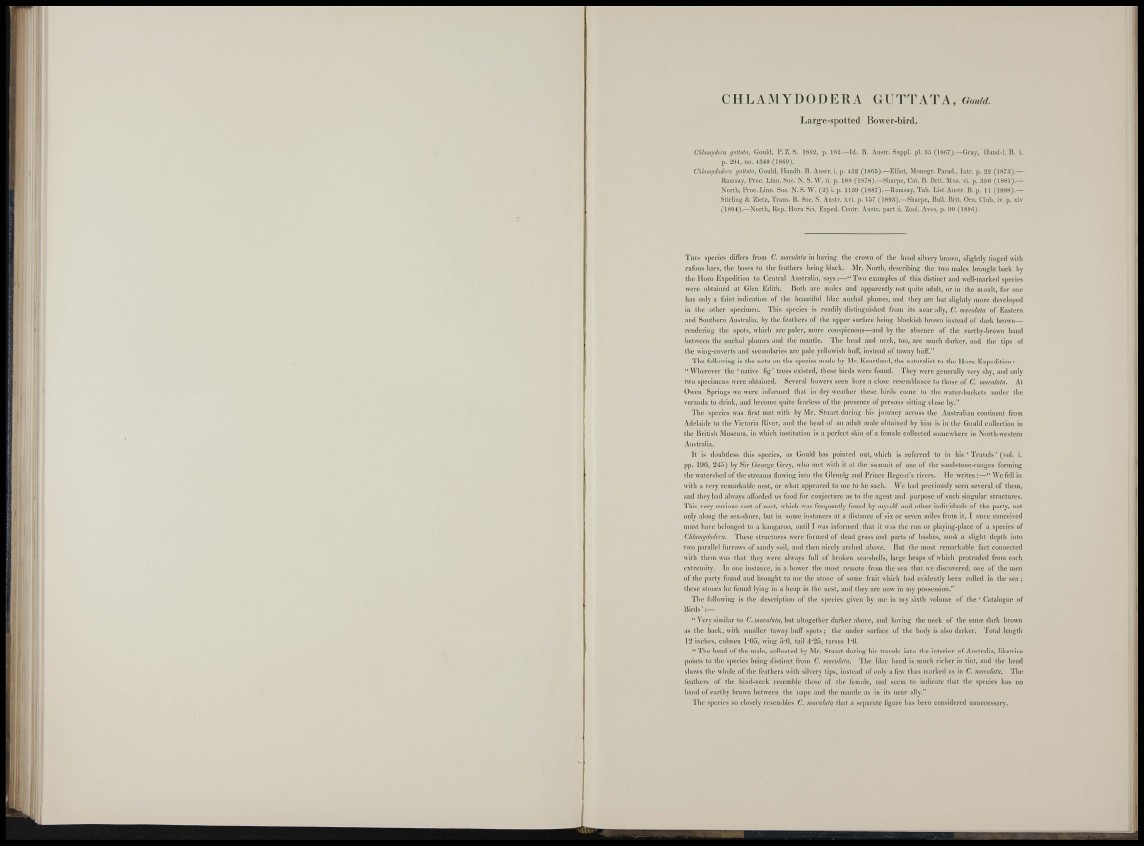
C H L A I M Y D O D E R A G U T A TA, Gou/d.
Larg-e-spotted liovver-bird.
Chhmyikm guttata, Gould, P. Z. S. 18(i2, p. I(i2.—Id. 15. Austr. Suppl. pi. ;!"> (1807).—Gray, Ilaiid-l. B. i.
p. 294, no. 4340 (1869).
Chlamyiodera guttata, Gould, Handb. B. Austr. i. p. 452 (1865).—Elliot, Monogr. Parad., Intr. p. 22 (187:)).—
Ramsay, Proc. Limi. Soc. N. S. W. ii. p. 188 (1878).—Sharpe, Cat. B. Brit. Mus. vi. p. :t!)0 (1881).—
North, Proc. Linn. Soc. N. S. W. (2) i. p. 1159 (1887).—Ramsay, Tab. List Austr. B. p. 11 (1888).—
Stirling & Zietz, Trans. R. Soc. S. Austr. xfi. p. 157 (1893).—Sharpe, Bull. Brit. Orn. Club, iv. p. xiv
(1894).—North, Rep. Horn Sci. Exped. Centr. Austr. part ii. Zool. Aves, p. 90 (1890).
T H I S spccies clifTcrs from C. maculata in liaving the crown of the head silvery hrown, slightly tinged with
rufous bars, the bases to the feathers being blacli. Mr. North, tieseribing the two males brought back by
the Horn E.vpedition to Central Australia, says:—"Two examples of this distinct and well-marked species
were obtained at Glen Edith. Both are males and apparently not quite adult, or it] the moult, for one
has only a faint indication of tlie beautiful lilac nuchal plumes, and they are but slightly more developed
in the other specimen. Thi.s species is readily distinguished from its near ally, C. maculata of Eastern
and Southern Australia, by the feathers of the upper surface being blackish brown instead of dark brown—
rendering the spots, whicli are jialer, more conspicuous—and by tlie absence of the earthy-brown baud
between the nuchal plumes and the mantle. The head and neck, too, are much darker, and the tips of
the wing-coverts and secondaries are pale yellowish bulf, instead of tawny bulf."
The following is the note on the species made by Mi-. Kearthuul, the naturalist to tiie Horn Expedition :—
"AVherever the 'native fig' trees existed, these birds were found. They were generally very shy, and only
two specimens were obtained. Several bowers seen bore a close resemblance to those of C, maculata. At
Owen Springs we were informed that in dry weather these birds couie to the water-buckets utider the
veranda to drink, and become t[uite fearless of the presence of persons sitting close by."
The species was first met with by Mr. Stuart during his journey across the Australian continent from
Adelaide to the Victoria River, and the head of an adult male obtained by him is in the Gould eollection in
the liritisli Museum, in which institution is a perfect skin of a female collected somewhere in North-western
Australia.
It is doubtless this species, as Gould has pointed out, which is referred to in his ' Travels' (vol. i.
p]). 196, 24o) by Sir George Grev, who met with it at the summit of one of the sandstone-ranges forming
the watershetl of the streams flowing into the Gleneig and Prince Regent's rivers. He writes ;—" We fell in
with a very remarkable nest, or what appeared to me to be such. Wc had previously seen several of theiii,
and they had always afforded us food for conjecture as to the agent and purpose of such singular structures.
This very curious sort of nest, which was frequently found by myself and otiier Individuals of the party, not
only along the sea-shore, but in some instances at a distance of six or seven miles from it, 1 once conceived
must have belonged to a kangaroo, initil I was Informed that it was the run or playing-place of a species of
Chlamijdotlera. These structm-es were forujcd of dead grass and parts of Inishes, sunk a slight depth iiito
two |)arallel furrows of sandy soil, and then nicely arched above. But the most remarkable fact connected
\\ lth theui was that they were always full of broken sea-shells, large heaps of whicii protruded from each
e.xtremity. In one instance, in a bower the most remote from the sea that we discovered, one of the men
of the jjarty found and brought to me the stone of some fruit whicii had evidently been rolled in the sea;
these stones he found lying in a iieap in the nest, and thev are now in my ]>ossesslon."
The following is the descrijition of the s))ccies given bv nie in my sixth volume of the ' Catalogue of
B i r d s ' : —
" Very similar to 6'. but altogether darker above, and having the neck of the same dark brown
as the back, with smaller tawny bull'spots ; the under surface of the body is also darkei-. Total length
1'2 inches, culmen 1'05, wing o"0, tail 4'!25, tarsus 1"6.
" T h e bead of the male, collected by Mr. Stuart during his travels into the interior of Ausfi'alia, likewise
points to the species being distinct from C. maculata. Tiie lilac band is much i-icher in tint, and the head
shows the whole of the featiiers v\jth silvery ti])s, instead of only a few thus marked as in C. maculata. The
feathers of the hiinl-neck resemble those of the female, and seem to indicate that the species has no
band of earthy brown between the nape and the mantle as in its near ally."
The species so closely resembles C. maculata that a separate figure has been considered lumecessary.
1